
Antoine Watteau, Pilgrimage to Cythere island, 1717, oil on canvas, Paris, musée du Louvre
© Musée du Louvre, Dist. RMN-GP / Angèle Dequier
Much of France has just been won in the first round of regional elections by the nearly fascist National Front whose leader, Marine Le Pen, fashions herself as the new Joan of Arc, moral crusader for family values and natural purity, a drag cousin to Donald Trump. But in the upper spheres of the art world, notably the Louvre Museum's shimmering branch in Lens, the very heart of Le Pen country, it's back to the libertine frolics of 18th Century.
Dansez, Embrassez Qui Vous Voudrez (Come Dance & Kiss Whoever You Want), is the title of the show. It celebrates the amorous parties organized by Louis XV's famed "first mistress" and counselor Madame de Pompadour. Mme. de Pompadour, recall, not only shepherded the leading Enlightenment philosophers, chief among them Voltaire, but she also committed herself to pleasuring the crown--in every sense of the term. Notably she led working girls into the Forest of Vincennes and staged sumptuous erotic romps for the aristocrats.

Hieronymus Janssens, A game of hot cockles, circa 1665-1670, oil on canvas, Paris, musée du Louvre
© RMN-GP (musée du Louvre) / Franck Raux
Why the Forest of Vincennes, which in recent times has also been the playground for gay sexual escapades? At the time the oldest profession had been banned from Paris proper and prostitution expelled to the city's edges. The forest of Vincennes was also a royal forest with its own grand chateau, a safe place for men in silk. Deeper into French mythology, forests were and still are deeply symbolic of vitality and security, not to forget the importance of wood to the pre-industrial economy. France's forests offered shelter when the light shined too bright.
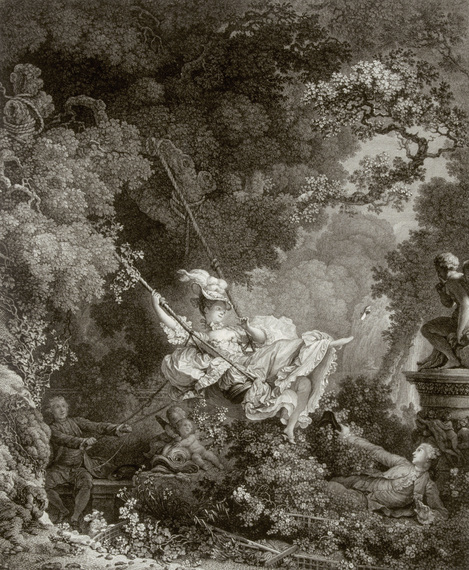
Nicolas de Launay after Jean-Honoré Fragonard, The happy coincidences of the swing, 1782, etching and engraving, Paris, musée du Louvre
© RMN-GP (musée du Louvre) / Thierry Le Mage
Look closely into the deeply didactic magnificence of the pieces. As older elegants surveyed the grandeur of the countryside, younger lads lay deep into their seductive poses ruffling the garments of their pursuits, or in one of the most frequently repeated tropes one of them would ease the comely girl onto a swing suspended from a grand oak and push her high so that his comrade could comfortably survey her tender undergarments.
Remote as all the 18th Century rococo design and dress may seem to the modern eye, the celebration of libertine excess was unexcelled even in late Rome or even late 20th Century Hollywood. Physical science was slowly creeping forward with more and more study of the human body as simply one of many animals in nature, the traffic in papal indulgences compared favorably with the porn traffic of today, and it was of course the high point in French culinary over-indulgence.
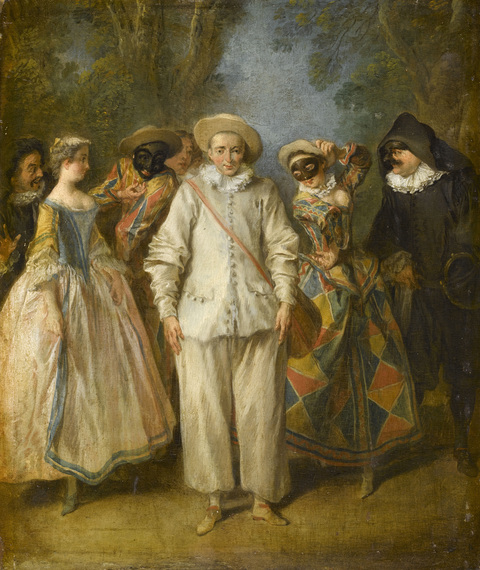
Nicolas Lancret, The falling curtain or The Actors of the Italian Comedy or The Italian Theatre, oil on wood, Paris, musée du Louvre
© RMN-GP (musée du Louvre) / Stéphane Maréchalle
At the same time better ships and roads carried the "scandalous" Italian theatre performers into the gilded theatres of Paris. Ever more separated from the barely literate peasantry, the rich sought personal stimulation in every domain--at least until the anger of the poor and the judgment of the protestants like Rousseau slowly began to bubble through the brush, and the call of the noble peasantry started to compete with silk ruffles.
The painters of the Academy--who in today's terms would double as film makers and television producers--began to turn their eyes from forest delights to "the real France" of farm and family upon which the nation's wealth had always relied. While Fragonard lost himself in bulbous busts and firm thighs, Jean-Baptiste Oudry celebrated barns and furrows, as in his famous La France or L'Agriculture.Traditional symbolism grew stronger: the fragile yet fecund rabbit; the loyal yet priopic goat; the purity of the nest and the double sense of security and imprisonment suggested by the cage--each an image that sought at once to celebrate the lovely lass but also to encircle her with probity and male authority be it in the park or the barnyard.
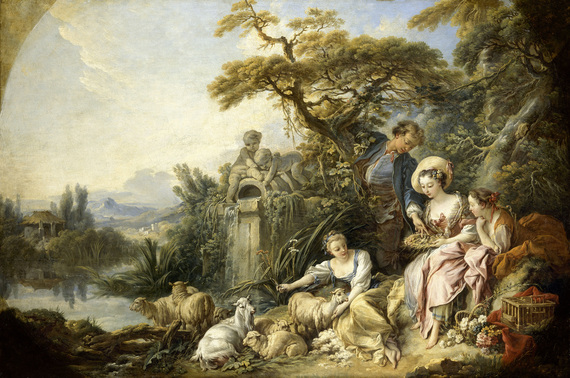
François Boucher, The Nest, also known as The Shepherd's Gift, oil on canvas, Paris, musée du Louvre
© RMN-GP (musée du Louvre) / Droits réservés
Sound familiar? Indulgent folly versus productive rectitude. Foreign corruption versus national heritage: the very themes that have brought today's far right National Front to its triumphant drum roll, echoed across the sea by the isolationist bombast of Donald Trump and Ted Cruz.
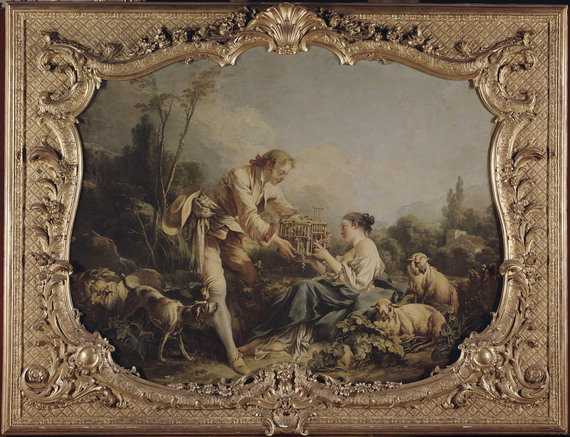
François Boucher, The gracious shepherd, circa 1738, oil on canvas, Paris, Archives nationales, Hôtel de Soubise
© RMN-GP / Droits réservés
It's all there in the works (and the words for those who care to scratch deeper) of the masterpieces of Antoine Watteau, François Boucher, Jean-Honoré Fragonard, Nicolas de Launay Francisco de Goya and their followers who with brush and stylus documented the first convulsions of modernism: persona liberty vs cultural tradition, themes that are only slightly shrouded in the denunciations that underlie today's American evangelicals and Muslim jihadists. Jihad had not yet been born in its current clothing during Mme. Pompadour's time, and aside from Calvin's deadly troops, the evangelicals were far away in the New World, but the tensions are clearly present in the detail of the artists' works.
France being France, however, never fully sacrificed the rococo and the baroque. The two styles, the pastoral and the indulgent marched side by side in the post-revolutionary 19th century until finally industry replaced the plow and the mass anxiety of real modernism broke out into the cubist and abstract chaos that was the 20th century. The brilliance of Mme. Pompadour and her philosophic-artistic circle deep in the 18th Century is just how much they set up the terms of what would emerge in their wake.
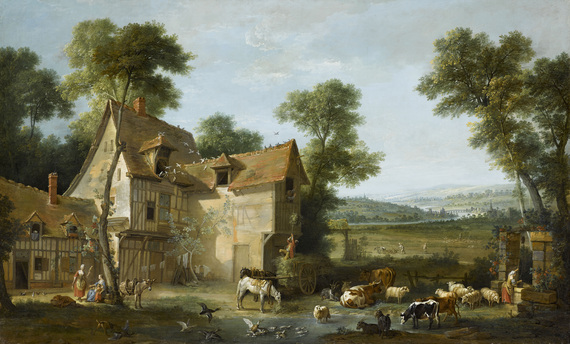
Jean-Baptiste Oudry, France or Agriculture, 1750, oil on canvas, Paris, musée du Louvre
© RMN-GP (musée du Louvre) / Mathieu Rabeau
